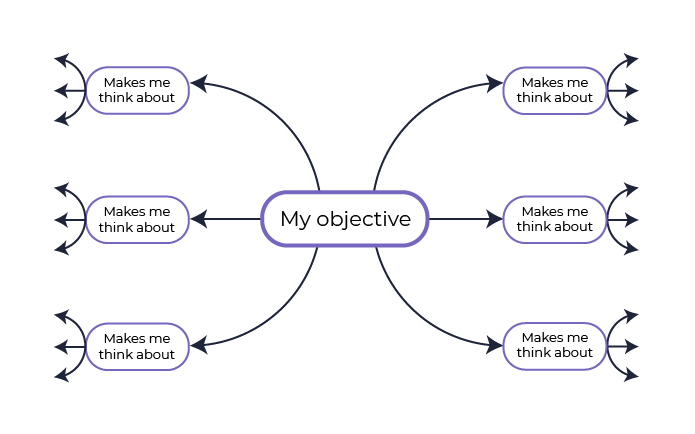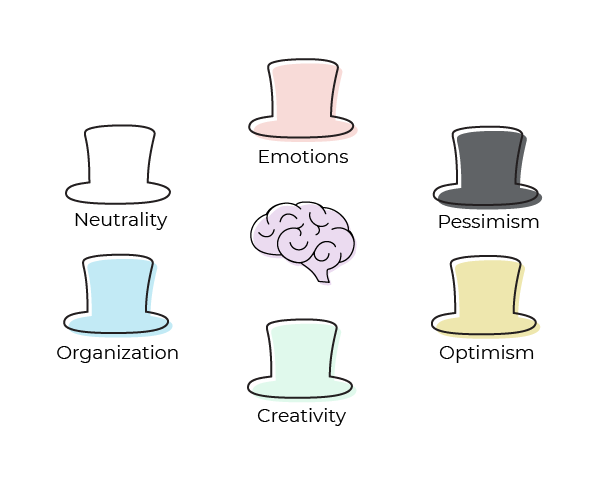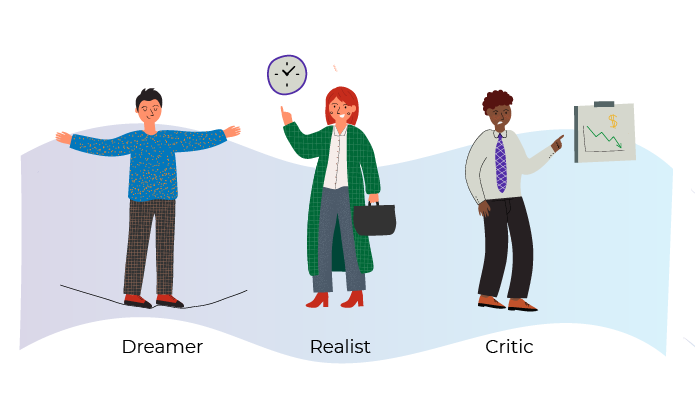The New Vision for Education highlights creativity as a top 10 managerial quality in 2020. Creativity is indeed a key soft skill that nourishes decision-making.
Practice Thinking Outside the Box
Through this way of thinking, you're able to solve problems and make innovative, off-the-beaten-track decisions by thinking for yourself.
Gaston Bachelard, a French philosopher who died in 1962, worked with dreams and imagination. He lists four essentials to boost creativity:
Free yourself from prejudices.
Avoid intellectual habits, always question yourself.
Challenge arguments from authority figures.
Let your reasoning remain open and fluid. Allow it to change over time.
How can you get out of the box?
To get out of the box and use your creativity, you should:
Identify the context without complacency or bias.
Break the mold or take a different look at your environment. Think about the "What if?". For example, "What if I give myself some slack?" "What if I go against the grain?"
Innovate and get out of the box: seek the unknown and the unpredictable. Defy conventions and typical processes. Put aside your certainties to explore the different and new. Let your imagination flourish and your thoughts wander while giving yourself permission to be creatively free.
If the philosophy is too much for you, think of it like this: If you try something new, you may discover something new. Look at a problem and consider an impossible solution; use a tool that isn't meant for a specific task; pretend you have a different job but are facing the same problem. In short, if you embrace a culture of disruption and play, you may gain unexpected insights.
For example, the well-known chef Jamie Oliver decided to go against convention by opening a chain of gourmet airport restaurants. Or Eileen Gray, who reinvented the field of modern architecture and design.
Do you also want to develop this ability to think outside of the box? Below are four techniques to broaden the field of possibilities before you make a choice.
Method #1: The Mind Map
Rather than writing a pros and cons list, try using a mind map to create a circular reflection. This map puts your objectives at the center and allows you to branch out your ideas.

For Emma, it could mean making a mind map around the question, "What's holding me back in my decision-making?" By answering the question, she could identify all the thoughts that come to mind when she thinks about her challenges.
You can also use this tool to find solutions to a problem: you can write down your problem in the center of the mind map and branch out all the solutions that come to mind.
It's Your Turn!

Do you have to make a decision and need to explore solutions? Write down your goal (or problem) in the middle of the mind map. Then write down all the ideas that come to mind around it.
Method #2: "Make a Decision in the Role of... "
Try a role-playing game in which you put yourself in someone else's shoes to make a decision. You'll act as a character very different from yourself and take a different look at your issues. This creative game allows you to:
Trigger ideas without the fear of mistakes.
Create a connection in a group.
Be unafraid of the consequences of your choices.
The game is dynamic. It moves you to act and makes decision-making more agile, flexible, and lively. This technique helps develop lateral thinking and brings out ideas that you may never have thought of. Use it to explore new ideas and tackle your decisions more creatively.
It's Your Turn!

Select a famous person from the following list. If possible, choose someone who is not from your professional world:
Scientific domain (Professor Raoult, Marie Curie, Freud).
Sports domain (Zinedine Zidane, Michael Jordan, David Beckham, etc.).
Artistic domain (Lady Gaga, Frida Kahlo, Johnny Hallyday, Picasso).
Political domain (Emmanuel Macron, Simone Veil, Michelle Obama, Donald Trump).
Business domain (Carlos Ghosn, Bernard Arnault, Jeff Bezos, Richard Branson).
John or Jane Doe (25-year-old Chinese woman, investigative journalist, anarchist).
Then:
Take 30 minutes to do an internet search on the life of the character you've chosen.
Write down all the points you've made in a mental map format.
Soak up the character's personality.
Answer the question: How would my character have responded to the problem?
By seeing the problem through a different lens, you force yourself to think differently.
Method #3: Use Bono's Thinking Hats
"Creativity involves breaking conventions in order to look at things in a new light." (Edward de Bono)
Okay, how does it work?
It's a straightforward process that allows you to think about a particular problem from six different angles. It's about wearing an imaginary hat and, depending on the hat's color, forcing yourself to think in the color's mode. This method allows you to escape your natural patterns. People tend to always imagine similar types of solutions, according to their beliefs and cognitive practices. Thus, an optimist will find it difficult to be analytical and critical, while an intuitive person, or someone who operates emotionally, will struggle to be factual. The point of this exercise is to encourage you to go beyond the usual framework.

There are six hats, six colors, and successively six ways of thinking. The aim is to move away from your systematic modes of thinking:
The white hat = neutrality.
The red hat = emotions.
The yellow hat = optimism.
The green hat = creativity.
The blue hat = organization.
The black hat = pessimism.
Let's go back to Emma, who wants to reinvent her career. In her scenario, when thinking about the solution she chose, she will use the Six Thinking Hats method to examine her choice by playing Devil's advocate when wearing the black hat.
She will then address her problem by:
Highlighting the dangers and risks.
Identifying the brakes and obstacles.
Asking herself about the pros and the cons.
Taking on the role of the pessimist.
Raising awareness.
Raising objections.
While wearing the black hat, Emma will ask herself the following questions:
What are the risks and limitations of this solution?
What are the disadvantages?
What's the worst-case scenario?
This method's power lies in the fact that she will adopt behaviors that are unnatural to her, which will, in turn, enrich her thinking.
The black hat is in direct opposition to Emma's optimistic side (yellow hat).
How is this method used collectively?
It's very simple. Here's a possible variation:
The facilitator wears the blue hat. His role is to facilitate the session and make sure everyone has their say. An additional person should take notes.
The facilitator explains the problem.
He lets each member of the group choose a different hat. If the session takes place face-to-face, you can print the hats on separate sheets of paper, and each speaker randomly draws their hat. In a virtual session, you can use a collaborative board.
Each person adopts their thinking about the problem to match their hat.
The facilitator manages the discussion among the six stakeholders.
Another group variant consists of asking all group members to wear the same hat simultaneously. It is then necessary to divide the session into six separate times and define, in advance, the order in which participants will wear the hats. The hats' sequence is determined in advance depending on the problem (for example, think in the white hat mode first, then red, then black, etc.).
It's Your Turn!

You can wear any of the six hats successively by asking yourself the right questions to move a complex project forward.
On your own, think about the Six Thinking Hats method to find innovative solutions to one of your problems:
Use each of the hats to put yourself into:
The neutral position (White: what are the facts?).
The organization position (Blue: what action plan should you implement?).
The caution position (Black: what's the worst possible solution or outcome?).
The intuitive position (Red: what feelings or emotions does this inspire in you?).
The creativity position (Green: what possible alternatives could there be?).
The optimism position (Yellow: what opportunities are there and how might they work?).
Record the solutions in your journal by putting on each hat and asking yourself the right questions.
Method #4: Use the Walt Disney Method
Are you wondering how to turn your dreams into reality? Copy Walt Disney!
This method consists of adopting three different angles of perception, or three different roles, before developing a strategy:

1.) The Dreamer
Creative, the dreamer is supposed to generate new ideas by asking themselves:
What's my goal, purpose, and objective?
How is this project positive for me?
What motivates me?
What will it bring me?
The dreamer thinks through "what."
2.) The Realist
Pragmatic and operational, this is the person who's practical and concrete. The realist takes a sober look at:
The implementation of the project.
The available resources.
The obstacles to avoid.
The people.
The feasibility of the project.
The realist thinks through "how."
3.) The Critic
The critic analyzes the project as a whole and in all the details, taking a critical look at:
The advantages/disadvantages.
The pros and cons.
The costs and budget.
The uncertainties and hazards.
The areas for improvement.
The critic thinks through "why."
After these three steps, you'll be able to develop a strategy.
Coordinating the three personalities in you: the dreamer, the realist, and the critic, you should keep the key elements of the most unique and original solutions and avoid restricting reason as much as possible.
Let’s see how our expert Ana Thorsdottir gets herself, and her team, to think outside the box.
Let's Recap!
In this chapter, you learned how to:
Think outside the box, think differently, and let go of certain conformity.
Use the mind map to expand your ideas.
Explore your approaches with the Six Thinking Hats, using different behavioral prisms to allow you to complete your vision.
Turn your dreams into reality using the Walt Disney strategy.
You're now ready to project yourself a little more and consider the consequences of each option before selecting one. See you in the next chapter!
